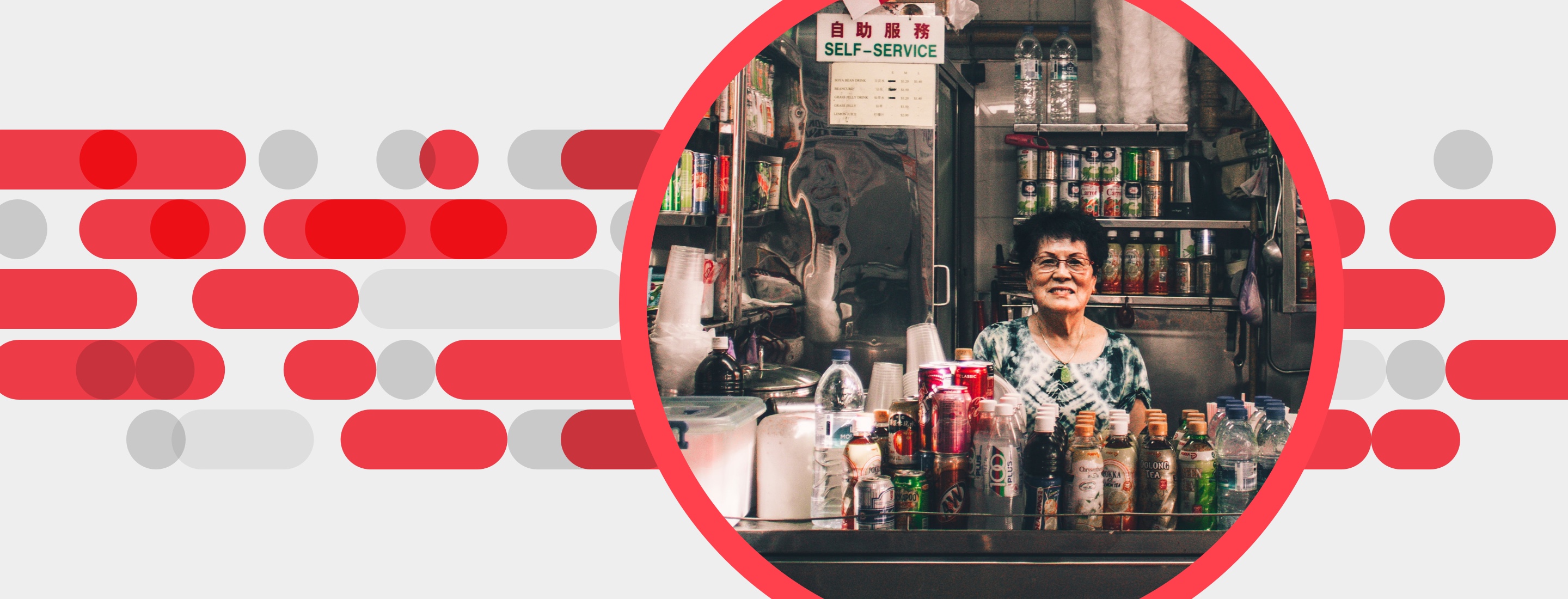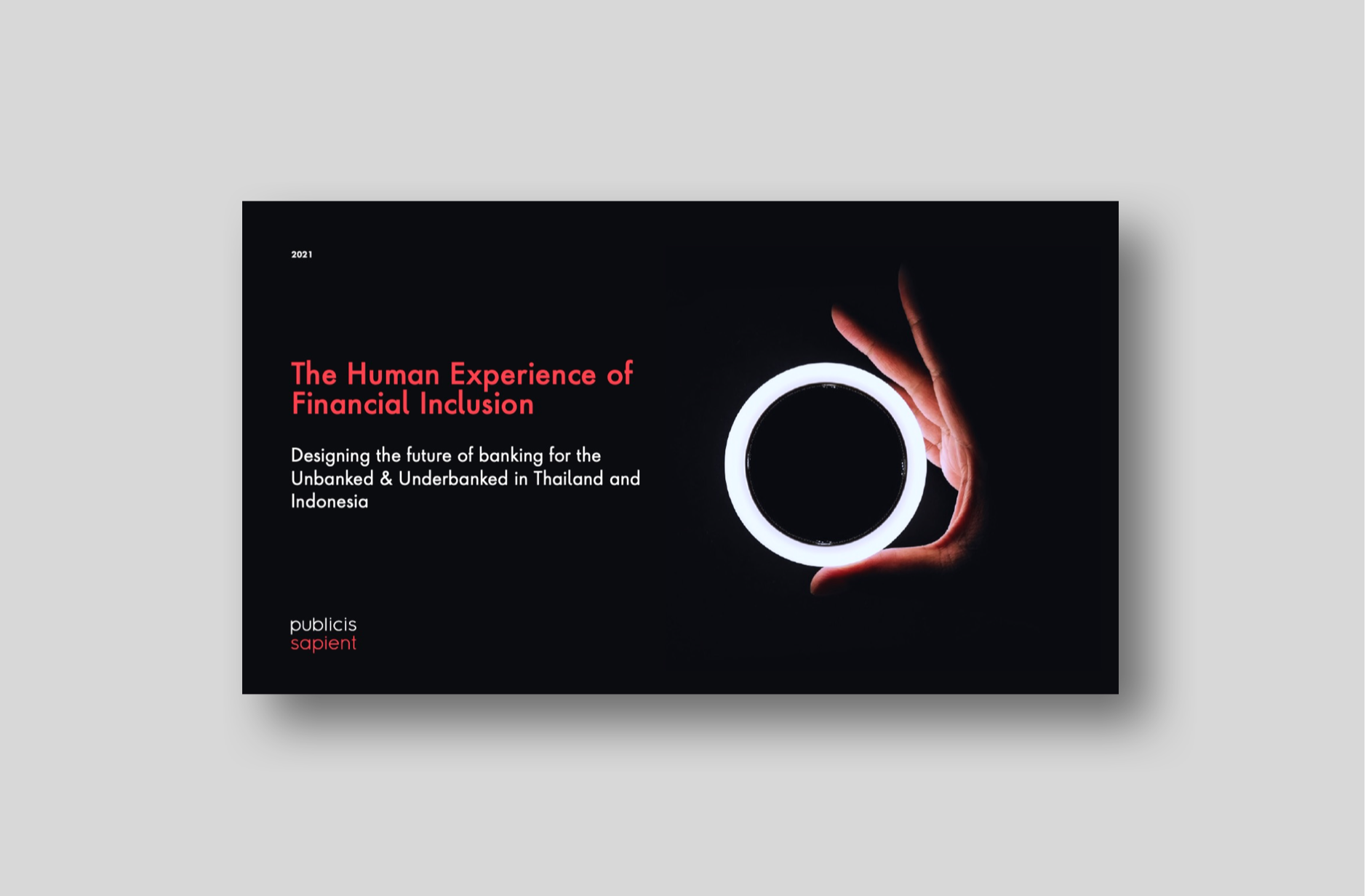What issue can we solve for you?
Type in your prompt above or try one of these suggestions
Suggested Prompt



Insight
Banks Must Support Financial Inclusion in Southeast Asia
Banks Must Support Financial Inclusion in Southeast Asia
Thanks to the pandemic, the uncertainty of the world economy has been especially devastating for those living on the poverty threshold and struggling to make ends meet. Many in this demographic lost much-needed jobs as the economy shrunk, while others hustled on the side, for example, as food sellers, to continue to put bread on the table.
In Thailand, the poverty rate increased from 6.2 percent to 8.8 percent in 2020, while Indonesia saw an uptick from 9.78 percent to 10.19 percent, according to the World Bank.
Ethnographic research by Publicis Sapient shows that there’s much more to understand about uplifting the livelihoods of those living at subsistence level in Southeast Asia, especially as financial inclusion efforts seek to serve the unbanked and underbanked in this region.
In the qualitative study of respondents in Indonesia and Thailand in 2021, Publicis Sapient found that their financial needs greatly varied as they moved through various stages in life. Upon finishing school, people enter the workforce and begin growing their income. Key life events like marriage and children soon enter the picture. This is where a number of families fall into the trough as new family members increase monthly household expenditure and cultural norms dictate the number of income streams a family can rely on. Some people in this situation begin exploring pathways like small business ownership to improve their family’s economic situation.
For many in this demography, financial stability comes in waves across their journey – savings rise when income flow is secure and stable. While at first the unbanked and underbanked may not seem to be viable customers for banks, a deeper understanding of their financial needs and practices reveals behaviors that are similar to that of standard bank customers. They spend, they save, and they borrow.
The ability to meet diverse financial needs at various life stages is key to the success of financial institutions in Southeast Asia, a booming region that expects $4.7 trillion in Gross Domestic Product (GDP) by 2025 and where 70 percent of the adult population is still unbanked or underbanked.
How financial institutions serve this customer segment deserves more consideration. Banks, for example, have to match their solutions to the specific needs of customers instead of delivering solutions that are one-size-for-all. Just as important is making use of digital innovations, such as mobile technologies, to serve more customers at scale.
An example, in the Philippines, CIMB uses its OCTO app to enable customers to open accounts seamlessly in 10 minutes, without initial deposit or maintaining balance requirements. In Thailand and Indonesia, TMRW uses a video call to verify a customer’s identity in its account opening drive for millennials. Customer queries are handled by TMRW's 24-hour chatbot that converses in Bahasa Indonesia.
How a bank develops its solutions for the unbanked and underbanked depends on how best to match the very different needs of this customer segment. To better understand this, the Publicis Sapient study seeks to rethink financial inclusion through the perspective of a life journey and make a difference to serving the underserved.
Understanding the various archetypes throughout these journeys helps banks to better understand their pain points and cater to their needs. The study identifies the following six archetypes, each with varying needs:
New kids on the block
Someone who is just starting a first full-time job and living alone. Income and savings, if any, are often in cash. In times of need, loans are typically only available from employers for emergencies. Here, financial literacy needs to be built from the ground up.
Independents
For individuals who have already entered the workforce but still rely on cash for daily wages and spending. Loans may come from informal community-based savings groups. Financial literacy is key though individuals in this group may already have a bank account through an employer.
Hopeful newlyweds
For hopeful newlyweds, typically employed full-time for a few years, the situation is more stable. The instinct here is to save a part of the salary received from employers.
Struggling family
As a couple starts having kids, they often find themselves fitting the “struggling families” archetype. Here, they often depend on out-of-system loans such as from friends or neighbors.
Future-ready parents
Moving up the ladder, more stable income earners are ready to invest in business opportunities. With a more reliable income, they also want more independence and security via a bank account.
Micro-entrepreneurs
Finally, individuals or families who run their own income stream, or micro-entrepreneurs may have already placed their savings in a bank, and they might may have made purchases, say, a motorcycle with credit from the bank.
The research by Publicis Sapient opens a new path of understanding the unbanked and underbanked population in the region by providing archetypes for their life journey. It is clear that financial institutions face different challenges in mapping out the needs of this group of customers as they transition through life.
Yes, reaching more customers is easier than ever – a phone, an app and a digital wallet can now connect thousands of customers without the bank having to open a branch in a remote area. There is no need to worry about physical infrastructure when the digital equivalent is much more scalable. That said, a bank’s relationship with a customer should be more than about enabling transactions. Knowing what a customer needs at a particular point in life allows banks to create experiences that matter. The financial products that an unbanked or underbanked customer wants at the start of their working life is very different to what they require at later stages in life. For a bank or lender to provide the financial tools and resources to empower these consumers as they too are uplifted in the future economic growth of Southeast Asia, a more bespoke approach is needed.

Download our Whitepaper
Find out how to develop compelling customer-centric solutions for both the unbanked and underbanked consumers in Southeast Asia.
Related Articles
-
![]()
What Australian Banks Should Learn From Buy Now, Pay Later (BNPL)
Banks are approaching the BNPL challenge in different ways. But which is the right approach for you?
-
![]()
SCB Tech X Launch: New Global Partnership Between SCBx Group and Publicis Sapient
New joint venture creates one of the largest fintech entities in Southeast Asia.
-
![]()
Financial Inclusion in Southeast Asia
We look at the significant opportunity that exists for both the financial industry and the people of Southeast Asia.







